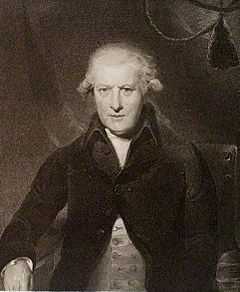William Barrington, 2nd Viscount Barrington
| The Right Honourable The Viscount Barrington PC | |
|---|---|
 | |
| Chancellor of the Exchequer | |
| In office 19 March 1761 – 29 May 1762 | |
| Monarch | George III |
| Prime Minister | The Duke of Newcastle |
| Preceded by | Hon. Henry Bilson Legge |
| Succeeded by | Sir Francis Dashwood, Bt |
| Personal details | |
| Born | 5 January 1717 |
| Died | 1 February 1793 (aged 76) Beckett Hall, Shrivenham, Berkshire |
| Nationality | British |
| Political party | Whig |
| Spouse(s) | Mary Lovell (d. 1764) |
William Wildman Shute Barrington, 2nd Viscount Barrington PC (5 January 1717 – 1 February 1793) was a British politician best known for his two periods as Secretary at War during Britain's involvement in the Seven Years War and American War of Independence.
Background
Barrington was the eldest son of John Barrington, 1st Viscount Barrington, by his wife Anne, daughter of Sir William Daines. The Hon. Daines Barrington, Rear-Admiral the Hon. Samuel Barrington and the Right Reverend the Hon. Shute Barrington, Bishop of Durham, were his younger brothers. He was educated at Geneva, Switzerland, and after succeeding to the title in 1734, he spent some time travelling.
Early political career
As Barrington's title was in the Peerage of Ireland it did not entitle him to a seat in the British House of Lords. In March 1740 he was returned to the House of Commons as Member of Parliament for Berwick-upon-Tweed (a seat his father had represented from 1714–23). Having taken his seat in the Irish House of Lords in 1745, he was appointed one of the Lords Commissioners of the Admiralty in 1746, and was one of the 'managers' of the impeachment of Lord Lovat.
Secretary at War
In 1754, he became Member of Parliament for Plymouth. In 1755 he was made a Privy Counsellor and appointed as Secretary at War in the cabinet of the Duke of Newcastle – a post which held for the next six years throughout the Seven Years' War. During this period his brother led an expedition that captured Guadeloupe.
In 1761 was transferred to the office of Chancellor of the Exchequer. In 1762 he became Treasurer of the Navy, and in 1765 returned to his former position of secretary at war. He retained this office until December 1778, and for four months in 1782 was joint postmaster-general.
Family
Lord Barrington married Mary, daughter of Henry Lovell and widow of the Hon. Samuel Grimston, in 1740. There were no surviving children from the marriage. She died in September 1764. Barrington remained a widower until his death at his country estate, Beckett Hall at Shrivenham in Berkshire (now Oxfordshire), in February 1793, aged 76. He was buried in St. Andrew's parish church, Shrivenham. His nephew William Barrington succeeded in the viscountcy.
Legacy
- namesake of Barrington, Nova Scotia[1]
References
 Chisholm, Hugh, ed. (1911). "Barrington, William Wildman Shute, 2nd Viscount". Encyclopædia Britannica (11th ed.). Cambridge University Press. which in turn cites:
Chisholm, Hugh, ed. (1911). "Barrington, William Wildman Shute, 2nd Viscount". Encyclopædia Britannica (11th ed.). Cambridge University Press. which in turn cites:
- Shute Barrington, Political Life of William Wildman, Viscount Barrington (London, 1814).
- Leigh Rayment's Historical List of MPs
External links
| Wikimedia Commons has media related to William Barrington, 2nd Viscount Barrington. |
| Parliament of Great Britain | ||
|---|---|---|
| Preceded by George Liddell Lord Polwarth |
Member of Parliament for Berwick-upon-Tweed with George Liddell 1740 Thomas Watson 1740–1754 1740–1754 |
Succeeded by Thomas Watson John Delaval |
| Preceded by Arthur Stert Charles Saunders |
Member of Parliament for Plymouth with Samuel Dicker 1754–1760 George Pocock 1760–1768 Francis Holburne 1768–1771 Sir Charles Hardy 1771–1778 1754–1778 |
Succeeded by Sir Charles Hardy Viscount Lewisham |
| Political offices | ||
| Preceded by Henry Fox |
Secretary at War 1755–1761 |
Succeeded by Charles Townshend |
| Preceded by Henry Bilson Legge |
Chancellor of the Exchequer 1761–1762 |
Succeeded by Sir Francis Dashwood |
| Preceded by George Grenville |
Treasurer of the Navy 1762–1765 |
Succeeded by The Viscount Howe |
| Preceded by Welbore Ellis |
Secretary at War 1765–1778 |
Succeeded by Charles Jenkinson |
| Preceded by Hon. Henry Carteret |
Postmaster General jointly with Hon. Henry Carteret 1782 |
Succeeded by The Earl of Tankerville and Hon. Henry Carteret |
| Court offices | ||
| Preceded by Sir Thomas Robinson |
Master of the Great Wardrobe 1754–1755 |
Succeeded by Sir Thomas Robinson |
| Peerage of Ireland | ||
| Preceded by John Shute Barrington |
Viscount Barrington 1734–1793 |
Succeeded by William Wildman Barrington |
|
.svg.png)